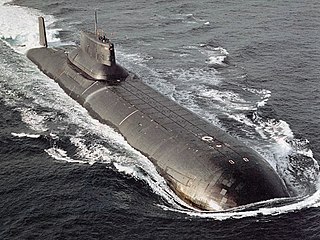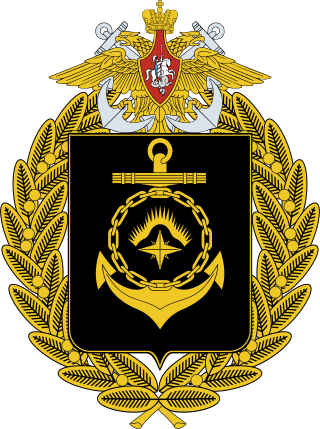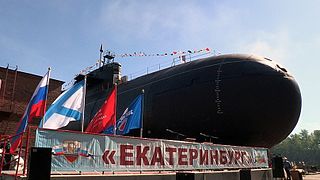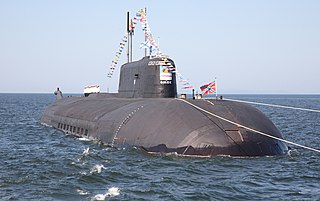Development and design
The design assignment was issued in 1969. The development of Project 949 was a new stage in the development of APRC-class submarines, which, in accordance with the concept of asymmetric response, were tasked with countering aircraft carrier strike formations. The new missile submarines were to replace the submarines of Projects 659 and 675 and in accordance with the terms of reference surpassed them in all basic parameters - could launch missiles from both surface and underwater position, had less noise, higher underwater speed, three times higher ammunition, missiles with radically improved combat capabilities. Project 949 became the pinnacle and the end of the development of highly specialized submarines (aircraft carrier killers).
In December 2011, they became known that the Rubin Central Design Bureau had developed a modernization project. It is planned to replace the P-700 missiles with the more modern P-800 Oniks missiles from the Caliber family. Modification of launch containers is planned, without alteration of the hull. The modernization of the nuclear submarine of the Northern Fleet will be carried out at the Zvezdochka CS, and the Zvezda shipyard. [3]
The design is double-hulled, with a distance between a light and durable body of 3.5 meters, which provides a significant buoyancy margin, up to 30 %, and provides additional protection against underwater explosions. For their characteristic appearance, they received the nickname baton, [4] and for their powerful strike weapons they were nicknamed aircraft carrier killers. The robust housing is divided into ten internal compartments. [5]
Construction and career
The submarine was laid down on 9 December 1986 at Sevmash, Severodvinsk. The vessel was launched on 20 January 1990 and commissioned on 22 December 1990.
In 1995, Smolensk performed an autonomous military service to the shores of Cuba. During autonomy, in the Sargasso Sea area, an accident occurred at the main power plant, the consequences were eliminated by the crew without losing secrecy and using security measures in two days. During the elimination of the malfunction, the turbinists of the 8th compartment especially distinguished themselves by sailors O. Kondratyev, R. Salimov, V. Rybalov, under the command of Lieutenant Commander V. N. Pavlyuk. All the assigned tasks of the combat service were completed successfully. [6]
In 1996, she began her autonomous combat service.
Smolensk was awarded the Commander-in-Chief of the Navy Prize for successful missile firing in 1993, 1994, 1998.
As of 2008, the K-410 Smolensk was in the combat composition of the Northern Fleet of the Russian Navy, based at Zaozersk, Zapadnaya Litsa.
In 2011, the submarine was delivered for repairs to the Zvezdochka Shipbuilding Center. In August 2012, the building berth stage of repairs was completed at the Smolensk APRK: on August 5, 2012, a dock operation was carried out to launch the ship. The final stage of work was carried out afloat at the outfitting embankment.
On 2 September 2013, the boat was at the dock of the Zvezdochka shipyard, when, during the tests of the main ballast tank of the nuclear submarine, the pressure tore off the Kingston pressure cap. There were no casualties or injuries. [7] On 23 December 2013, after the completed repairs, Smolensk went to sea to carry out a program of factory sea trials. During the repair on the cruiser, the technical readiness of all the ship's systems was restored, including the mechanical part, electronic weapons, hull structures and the main power plant. The submarine's reactors were recharged and the weapons complex was repaired. The service life of the submarine missile carrier was extended by 3.5 years, after which it is planned to begin work on a deep modernization of the ship. It was planned that by the end of 2013 the crew of the cruiser and the factory commissioning team would check all the systems of the ship in the conditions of the test sites in the White Sea. After that, the submarine was sent to his permanent base on the Kola Peninsula. [8]
In September 2014, the submarine took part in tactical exercises of the diverse forces of the Northern Fleet. [9]
On 16 October 2016, the submarine launched a Granit missile from a submerged position in the Barents Sea at a target on the Novaya Zemlya archipelago in the Arctic, as part of the final combat training activities for the 2016 academic year. The shooting was successful, the rocket hit the target, which was located in the depths of the coast of the Northern island of the Novaya Zemlya archipelago. [10]
On 5 July 2017, the submarine from a submerged position destroyed a sea target in the water area of the Barents Sea, located at a distance of about 400 kilometres (250 mi) with a Granit cruise missile. [11]
In July 2019, the submarine took part in the celebration of the Navy Day on the roadstead of Kronstadt.
In June 2022, the submarine took part in exercises in which she engaged in the practice firing of Kalibr and Granit cruise missiles. [12]

The Oscar class, Soviet designations Project 949 Granit and Project 949A Antey, are a series of nuclear-powered cruise missile submarines designed in the Soviet Union for the Soviet Navy. First built in the 1970s, six remain in service with the Russian Navy. Two other vessels were slated to be modernized since at least 2017 as Project 949AM, to extend their service life and increase combat capabilities but it is unclear whether work continues as of 2023.

The Typhoon class, Soviet designation Project 941 Akula, is a class of nuclear-powered ballistic missile submarines designed and built by the Soviet Union for the Soviet Navy. With a submerged displacement of 48,000 tonnes, the Typhoons are the largest submarines ever built, able to accommodate comfortable living facilities for the crew of 160 when submerged for months on end. The source of the NATO reporting name remains unclear, although it is often claimed to be related to the use of the word "typhoon" ("тайфун") by General Secretary Leonid Brezhnev of the Communist Party in a 1974 speech while describing a new type of nuclear ballistic missile submarine, as a reaction to the United States Navy's new Ohio-class submarine.

The Northern Fleet is the fleet of the Russian Navy in the Arctic.

Kirov is the lead ship of the Kirov class of nuclear-powered guided missile cruisers. Originally built for the Soviet Navy and passed onto the succeeding Russian Navy, she and her three sister ships are the largest and heaviest surface combatant warships built by them. The Soviet classification of the ship-type is "heavy nuclear-powered guided missile cruiser", nonetheless Kirov's size and weapons complement have earned her the unofficial designation of a battlecruiser throughout much of the world, as her size and displacement is similar to a typical World War I battleship. The appearance of the Kirov class was a significant factor in the U.S. Navy recommissioning the Iowa class. She was named after a Project 26 cruiser.

The Delta class, Soviet designations Project 667B Murena, Project 667BD Murena-M, Project 667BDR Kalmar, Project 667BDRM Delfin, are a family of nuclear-powered ballistic missile submarines, designed and built in the Soviet Union, which formed the backbone of the Soviet and Russian strategic submarine fleet since their introduction in 1973. They carry nuclear ballistic missiles of the R-29 Vysota family, with the Delta I, Delta II, Delta III and Delta IV classes carrying the R-29/SS-N-8 'Sawfly', R-29D/SS-N-8 'Sawfly', R-29R/SS-N-18 'Stingray' and R-29RM/SS-N-23 'Skiff' respectively.

The Sierra class, Soviet designations Project 945 Barrakuda and Project 945A Kondor,, are a series of nuclear-powered attack submarines intended for the Soviet Navy and currently in service with the Russian Navy.
B-276 Kostroma is a Russian Sierra-class submarine. She was launched in 1986, commissioned in 1987, and named K-276 Crab until 1992. Kostroma was built at Gorky and later towed to Severodvinsk for completion. She is part of the Russian Northern Fleet.

K-560 Severodvinsk is a Yasen class nuclear-powered cruise missile submarine of the Russian Navy, and the lead vessel of the class. The submarine is named after the city of Severodvinsk. She is deployed with the Russian Northern Fleet.

K-561 Kazan is a Yasen-class nuclear-powered cruise missile submarine of the Russian Navy. It is the second boat of the project, separated from the first by 16 years (1993–2009). Considerable changes were made to the initial design. Differences in the project have appeared sufficient to consider it as a new upgraded version Yasen-M. The submarine is named after the city of Kazan. The submarine is deployed with the Russian Northern Fleet.
BS-64 is a Project 667BDRM Delfin-class ballistic missile submarine of the Russian Navy. She was originally designated K-64.

K-84 Ekaterinburg is a Project 667BDRM Delfin-class nuclear-powered ballistic missile submarine. The submarine was laid down on 17 February 1982 at the Russian Northern Machine-Building Enterprise (Sevmash). It was commissioned into the Soviet Navy on 30 December 1985. After the collapse of the Soviet Union, the submarine continued to serve in the Russian Navy. Initially known only by its hull number, in February 1999 it was renamed after the city of Yekaterinburg.

K-114 Tula is a Project 667BDRM Delfin-class nuclear-powered ballistic missile submarine (SSBN). As such, she carries a complement of R-29RM Shtil and R-29RMU Sineva nuclear submarine-launched ballistic missiles (SLBM) as her primary deterrent mission, along with anti-ship missiles and torpedoes, the latter for self-defense. Built in Severodvinsk during the late 1980s, she served with the Soviet Navy before being transferred to the Russian Navy following the dissolution of the Soviet Union. Tula underwent an extensive overhaul during 2000–2004 and was fitted with upgraded Shtil SLBMs, several of which were launched from her during her later operational life. She was sponsored by the city of Tula, and is homeported in Gadzhiyevo.

K-266 Orel is a Project 949AM nuclear-powered cruise missile submarine (SSGN). She is one of three Oscar II submarines still serving in the Russian Northern Fleet, all assigned to the 11th Submarine Division, berthed at Guba Bolshaya Lopatka, on the Kola Peninsula northwest of Severomorsk.
The 3M22 Zircon also spelled as 3M22 Tsirkon is a scramjet powered maneuvering anti-ship hypersonic cruise missile produced by Russia for the Russian Navy, with launch platforms on frigates and submarines.
The K-119 Voronezh is an Oscar-class submarine in the Russian Navy.

The K-150 Tomsk is an Oscar-class submarine in the Russian Navy.

The K-186 Omsk is an Oscar-class submarine in the Russian Navy.
The K-132 Irkutsk is an Oscar-class submarine in the Russian Navy.
The K-391 Bratsk is an Akula-class submarine in the Russian Navy.
The K-461 Volk (En:Wolf) is an Akula-class submarine of the Russian Navy.












